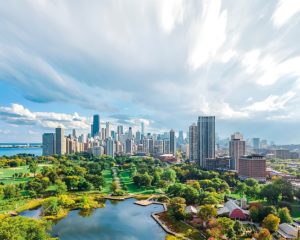Seawater Desalination to Quench Thirst
Drinking water is a valuable elixir, which remains limited in some regions of the world, or even unavailable. Both man and industry suffer from lack of water. Desalination of seawater offers a way out, but the technology has very high requirements. Plant manufacturers are therefore thirsting for robust and energy efficient pumps.
Scarce drinking water today already is a major challenge for arid countries. The United Nations estimate that roughly 800 million people do not have access to the resource. And the outlook isn t good: in the next decades their number could grow to two billion. Reasons are population growth, climate change, increasing environmental pollution, climate change and freshwater pollution in industrialised nations.
Seawater a source for drinking water
Closely considered the problems appear surprising, as water is abundant on the blue planet. However, only 0.3 percent of all the water on earth are usable. This in turn means that there is potential that can be leveraged, namely through seawater desalination. Seawater becomes a source for drinking water – but an improved energy balance is needed for the technology to triumph. Manufacturers are already feverishly working on overcoming this hurdle. Seawater desalination plants have a decades long development behind them and are prevailing in the market. For Europe the era of desalination began in 1964, exactly fifty years ago, when the first plant was constructed on the Spanish Canary Island Lanzarote. And demand for seawater desalination plants still isn t saturated. Quite on the contrary. In countries in the Middle East and the Gulf region drinking water is won through desalination plants. High-capacity plants are still being constructed today. Halberg, for instance, won a lucrative deal for Saudi Arabia: the company will deliver five large condensate pumps (designed as barrel pumps) and two boiler feed pumps with a total value of about 5 million euro for a major scale seawater desalination project.
Water shortage in Dixieland
Even western industrial nations increasingly need drinking water. More and more US states such as California, Florida and Texas are facing problems. Rising aridity, growing populations and diminishing water resources are becoming more and more of a threat to man and the economy. For seawater desalination “in Texas there is lots of potential,” states “Germany Trade & Invest” (GT&I), the economic development agency of the Federal Republic of Germany. By 2060, the population will nearly double. At the same time “groundwater ressources will decrease by ten percent,” foresees the Texas Water Development Board (TWBD). Enough salt water is available to supply the need for water in the coming 175 years. The TWBD is placing its bets on desalination plants: by 2060 the percentage of drinking water from desalination plants is to grow from 0.7 to 3.4 percent in Texas. Planning for new large-scale projects has already begun. The city of San Antonio, for instance, is investing around 145 million US dollars in a brackish water desalination plant.
Trend towards large-scale desalination plants
“The market is also developing dynamically in Florida,” reports GT&I. According to the Florida Department of Environmental Protection (DEP), water consumption will rise from 6.5 billion to 8.5 billion gallons per day (gpd) by 2025. Already two years ago the federal state already had the largest share of desalination plants for drinking water supply in the country, with about 150. In California “a trend can be identified towards large-scale desalination plants,” claims the GT&I. In the southern part of the US federal state fresh water sources are increasingly threatened by the influx of brine. In addition, the Colorado River is losing volume, an important source. A danger foreseen now half avoided? Poseidon Resources in any case is investing close to one billion US dollars in a mega project, with a capacity of 50 million gpd. „By 2016 seven percent of drinking water needs of San Diego County will be covered”. Reverse osmosis is the prevalent desalination technology in the USA. Pumps press seawater through membranes, thereby removing salt. “There is increasing demand from plant operators for efficient pumps and robust membranes,” analyses GT&I. “High-pressure pumps feeding the membranes with seawater form the heart of reverse osmosis plants”, explains “Düchting Pumpen”. For optimal efficiencies, especially designed hydraulics are important.
Energy efficiency of high priority for pumps
A central challenge for new desalination plants is energy efficiency and economical operation. One example: in the final phase of the process a concentrate stream with high kinetic energy is available that can be used for energy recovery, allowing to considerably reduce energy requirements, states Düchting. A Pelton turbine is used to lead back energy into the system by coupling the turbine shaft directly to the pump shaft. “This helps to reduce the power of the drive that needs to be installed for the high-pressure pump”. Grundfos also sees energy efficiency as a high priority. The German company equips one-stage and two-stage reverse osmosis facilities with pumping systems. Recovering kinetic energy from unused raw water helps reduce power consumption. This is implemented through a pumping turbine on the pressure side. As Grundfos explains, seawater is mostly treated at the source, in order to drain off the concentrate and reduce risk corrosion. Depending on the flow requirements and the salt content, a seawater intake may be hundreds of meters out to sea, while an on-shore seawater intake could be corrosion-safe beach wells or coastal bank filtration. Land-based seawater intake has the advantage that the risk of corrosion is lower and water is prefiltered. For this application there are pumps for both submerged and dry use.
Negative pressure evaporates water
Numerous desalination plants use the evaporation process in the Persion Gulf, where seawater has up to 45 grams of salt per liter. Seawater is heated up to the boiling point and then channeled into chambers that are 20 meters long and four meters wide. “Water vaporizes as a result of the negative pressure in the chambers,” explains Clemens Wolters of Bilfinger Deutsche Babcock Middle East. Steam condenses on bundles made up of thousands of thin cooling tubes. “Drops of fresh water are the treasure that is withdrawn and collected”, Wolters adds. 15 to 20 of such chambers with ever-increasing levels of negative pressure are chained together to produce as much fresh water as possible. Seawater also flows through the cooling pipes – initially, seawater in the tubes serves as a cooling medium which ensures that the steam in the chambers condenses. Wolters: “Then the saltwater is brought to a boil outside the chambers before it is funneled back inside to evaporise”.
“Bypasses” relieve pumps
In order to make the process more efficient, the speed of the saltwater that running through the cooling tubes and the vaporizing chambers has to be increased, which in turn causes problems: “When the water is pushed through many thousands of small cooling water tubes, frictional resistance increases dramatically”, states Wolters. Neither pipes nor pumps would hold out very long.
Bilfinger therefore uses bypasses: The water boxes are directly connected with high-caliber pipes so that not all of the process water needs to be pumped through the delicate cooling tubes. “As a result, tubes and pumps are spared while the water and steam flow rate is increased”.
Siemens also aims at decreasing energy consumption. The company s engineers developed an electrochemical desalination process. This process combine electrodialysis and continuous electrodeionisation. “Both technologies work with an electric field, in order to remove sodium and chloride ions from the water, using ion exchange membranes”, Siemens explains. As the water doesn t have to be forced through a membrane, the process only requires low pressure levels and low levels of energy.
Monitoring pumps around the clock
A pumping system in a desalination plant naturally can t be reduced to just energy efficiency. Attention has to be paid that the plant is also operated safely. Grundfos combines a motor protection device with around the clock monitoring: this way, dry running and overload can detected and prevented.
The medium flows through to the motor to cool it, through a specially designed body. Furthermore, “Pleuger Polderpumpen” places the pump component under the motor, ensuring a lower pump inlet.
What is important for reverse osmosis is to protect pumps and membranes against being damaged through fine filtration, emphasises AquaCare. The high water pressure also needs to be coped with. Here, the company uses piston pumps, which can operate at and resist pressures of up to 80 bar. In order to suppress the damaging effects of the so-called water hammer, the main pumps are equipped with frequency controls, which makes a gentle starting and stopping possible, too,” states AquaCare. In addition, the operating pressure (depending on temperature, salinity and age of the membranes) can be controlled by the frequency of the pump, allowing energy to be saved.
Rinsing system parts with pure water
During operation, after stopping the system or after failures all parts that have come into contact with sea water need to be rinsed with pure water (permeate).
When in operation, the clean in place (CIP) system collects water in an extra tank, which is then used to clean the system. After operation, a small stainless steel pump pumps pure water through the system, replacing seawater. “This procedure prevents organic digestive processes at the membranes and reduces corrosion”, explains AquaCare.
Talking of corrosion: preventing corrosion is seen as a major challenge for all pump manufacturers in the field of desalination technology. A proven way is using a robust material. Suitable for instance are alloys with nickel content, austenitic stainless steels and nickel-base alloys, which not only withstand corrosion, but also fouling and high flow velocities.
A suitable material already has to be chosen for vacuum water deaeration, one step before the desalinatino process. Corosys used steel as a material, on the inside coated with a highly-resistant rubber coating and on the outside with a special coating out of paint and sealing. Furthermore, the pumps are bronze-fitted; pipes and valves are made from plastic.
Eco-friendliness as a selling point
Environmental aspects are increasingly crucial for a desalination project. Apart from the energy efficiency of pumps, the salt brine also poses a problem that needs to be solved. Salt brine is produced during the desalination process, and is around twice as salty as seawater. A disposal is required especially where the salt brine can come into contact with sensitive species. Environmental activists fear damages to flora and fauna.
One example for an environmentally disposal of salt brine could be the following: several desalination plants are close to power plants. This allows salt brine to be pumped to them. Here, the brine is mixed with cooling water and thus diluted.
Pump manufacturers who not only place value on quality, but also on the eco-friendliness of their products, can expect lucrative contracts. If both aspects are fulfilled, its grist to a pump makers mill!







